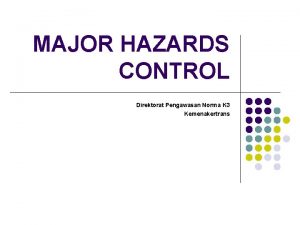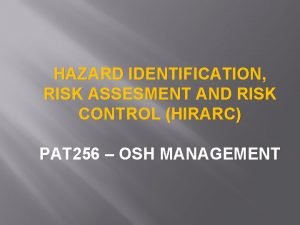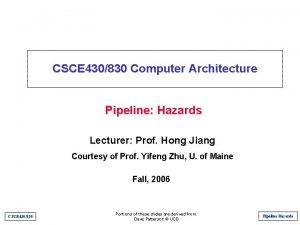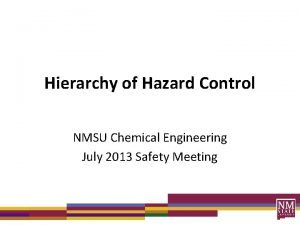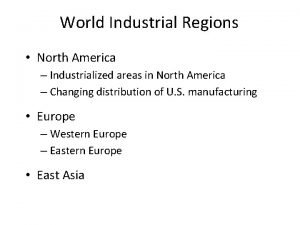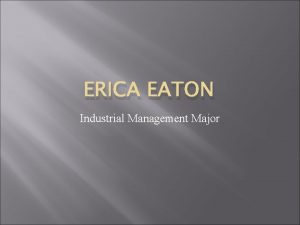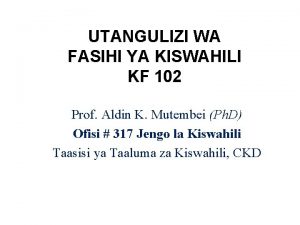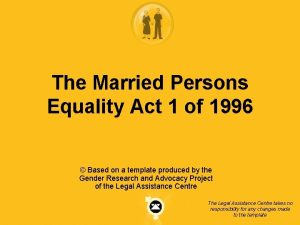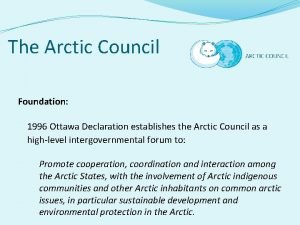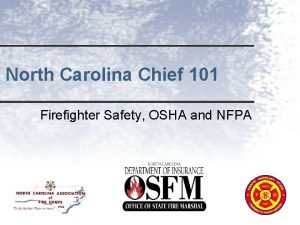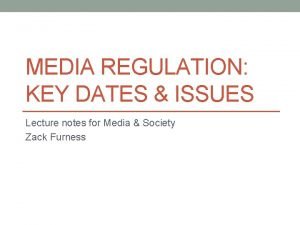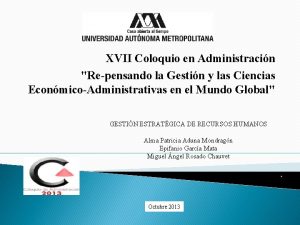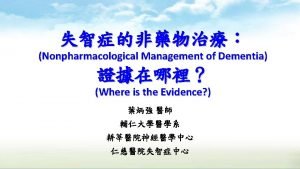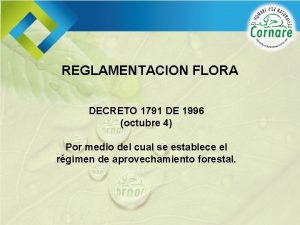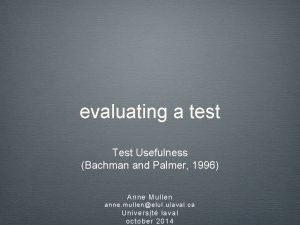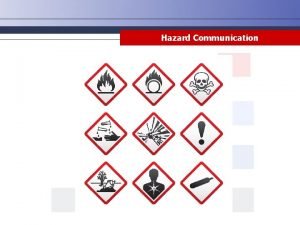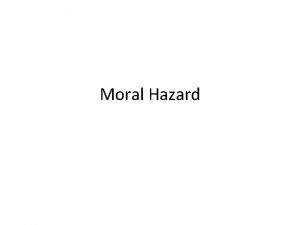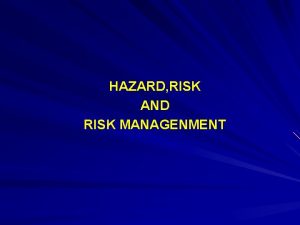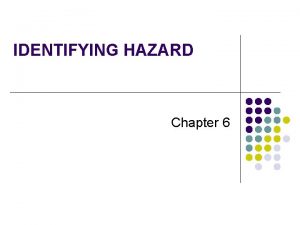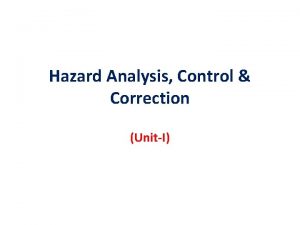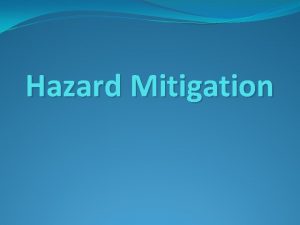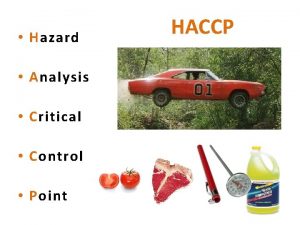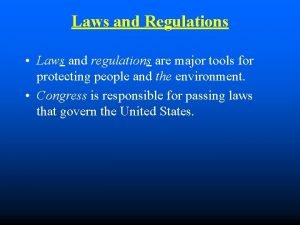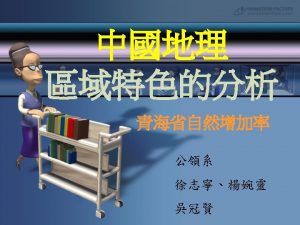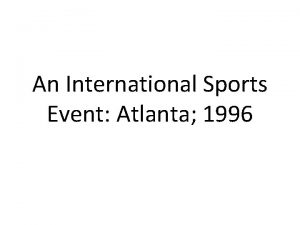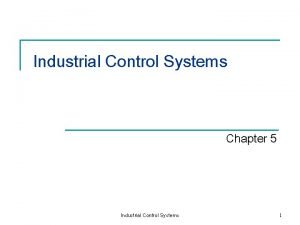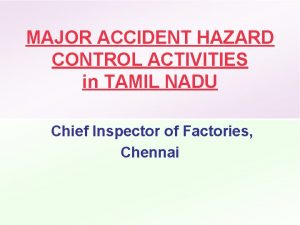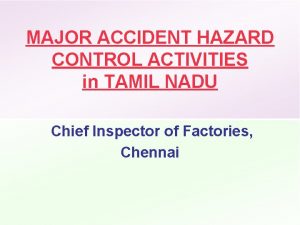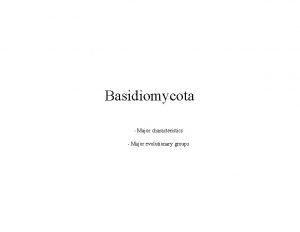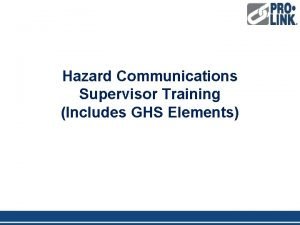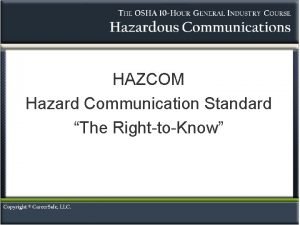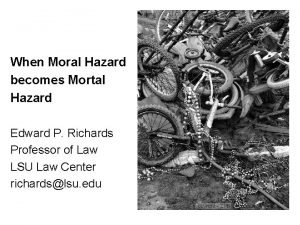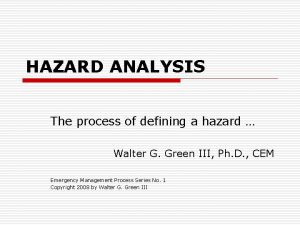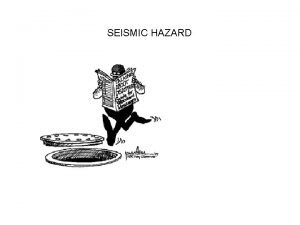Control of Industrial Major Hazard CIMAH Regulations 1996



































- Slides: 35

Control of Industrial Major Hazard (CIMAH) Regulations 1996 USMAN SHAREEF MKK 162015

BACKGROUND Mid 1970’s European Community government passed regulations about major hazard directive in chemical process facilities (SEVESO DIRECTIVE) 1984 Britain enforced the directive, known as the Control of Industrial Major Hazard (CIMAH) regulations 1996 The government of Malaysia adopted the CIMAH regulations

CIMAH Regulations 1996 CIMAH Objectives : 1. To prevent major accidents 2. To limit the consequences to people and environment This regulations apply to all industrial activities, except : i. A nuclear installation ii. An installation under the armed forces iii. A vehicle or vessel transporting hazardous substances to or from the site of an industrial activity iv. An industrial activity where quantity of hazardous substance equal or less than 10% of threshold quantity of hazardous substance(s) Those four industrial activity is well-known as Not To Comply (NTC)

ARRANGEMENT OF CIMAH REGULATION 1996 PART I – PRELIMINARY Regulation 1. Citation and commencement. Regulation 2. Application. Regulation 3. Interpretation. Regulation 4. Limitation of power of officer. Regulation 5. Obligations of manufacturer and employee. PART II - IDENTIFICATION AND NOTIFICATION OF AN INDUSTRIAL ACTIVITY Regulation 6. Application. Regulation 7. Identification and notification. Regulation 8. Notification of change. PART III - DEMONSTRATION OF SAFE OPERATION FOR NON-MAJOR HAZARD INSTALLATION Regulation 9. Application. Regulation 10. Demonstration of safe operation. Regulation 11. Review of demonstration of safe operati PART IV - REPORT ON INDUSTRIAL ACTIVITY AND PREPARATION OF EMERGENCY PLAN FOR MAJOR HAZARD INSTALLATION Regulation 12. Application. Regulation 13. Registration of Competent Person. Regulation 14. Report on industrial activity. Regulation 15. Modification.

Regulation 16. Updating of report. Regulation 17. Review of report. Regulation 18. On-site emergency plan. Regulation 19. Updating of on-site emergency plan. Regulation 20. Review of on-site emergency plan. Regulation 21. Off-site emergency plan. Regulation 22. Information to the public. PART V - NOTIFICATION OF MAJOR ACCIDENT Regulation 23. Notification of major accident. PART VI – PENALTY Regulation 24. Penalty. SCHEDULE 1 SCHEDULE 2 SCHEDULE 3 SCHEDULE 4 SCHEDULE 5 SCHEDULE 6

TERM Within CIMAH Regulations 1996 Competent Person - An employee or person appointed by the manufacturer and who has been approved by the Director General to prepare a written report Register Person – An employee or person who has been appointed by an authority to approve a report such as the report of Environmental Impact Assessment (EIA) Manufacturer - An employer or occupier having control of an industrial activity Officer - Occupational safety and health officer appointed Industrial Activity - An operation carried out in an industrial installation involving one or more hazardous substances, and includes on-site storage and on-site transport which are associated with the operation Local Authority - any council or other similar local authority established by any written law and includes any authority in charge of a Federal Territory established by any written law Port Authority - any port authority established under any written law Major Accident - An occurrence including a major emission, fire or explosion resulting from uncontrolled development in the course of an industrial activity, which leads to serious danger to persons, whether immediate or delayed, inside or outside an installation, or to the environment, and involving one or more hazardous substance Threshold Quantity - In relation to a given hazardous substance or a category(s) of hazardous substances, means the quantity(s) which is or are equal to the amount set out in Schedule 2

Classification Of Industrial Activity CIMAH REGULATIONS Quantity of Hazardous Substances (QHS) MAJOR HAZARD INSTALLATION (MHI) NON MAJOR HAZARD INSTALLATION (NMHI) QHS ≥ Treshold Quantity (TQ) 10% TQ < QHS < TQ Submit industrial activity report Submit document demonstration of safe operation (including element of ERP) Reference : Guidline of preparation on Department of Occupational Safety and Health (DOSH) Submit onsite Emergency Response Plan (ERP) Supply information to public Supply information to local/port authority (offsite ERP)

CIMAH Indicative Criteria Toxic Substances Very Toxic TQ = 5 tonnes Other Toxic TQ = 10 tonnes Explosive Substances Highly Flammable Liquid Toxic TQ = Refer Sch. 2, Part 1 Flammable Substances TQ = 10 tonnes TQ = 5000 tonnes Flammable Liquid Oxiding Substances Flammable Gas TQ = 10 tonnes TQ = 200 tonnes TQ = 50 tonnes

PENALTY • The manufacturer who commits an offence against any of the provisions of these regulations for which no corresponding penalty is provided by the Act shall, on conviction, be liable to a fine not exceeding RM 50, 000 or to an imprisonment of not more than two years or to both. • Any employee who commits an offence against any of the provisions of these regulations for which no corresponding penalty is provided by the Act shall, on conviction, be liable to a fine not exceeding RM 1, 000 or to an imprisonment of not more than three months or to both.

ADDITIONAL SLIDE

SCHEDULE 1 For the purpose of this schedule : LD 50 (oral) - a dose of a substance in mg/kg of body weight that produces death in 50% of a given experimental animal population LD 50 (cutaneous) - a dose of a substance in mg/kg of body weight that produces death in 50% of a given animal population LC 50 - a concentration of a substance in air that is estimated to produce death after inhalation for four hours in 50% of a given experimental animal population FLAMMABLE SUBSTANCES Highly Flammable Liquids substances which have a flash point lower than 21 C and the boiling point of which at normal pressure is above 20 C Flammable Liquids substances which have a flash point lower than 5. 5 C and which remain liquid under pressure and where under particular processing conditions such as high pressure and high temperature, may create major accident hazards Flammable Gases substances which in the gaseous state at normal pressure and mixed with air become flammable and the boiling point of which at normal pressure is 20 C or below EXPLOSIVE SUBSTANCES Substances which may explode under the effect of flame or which are more sensitive to shocks or friction than dinitrobenzene

SCHEDULE 1 TOXIC SUBSTANCES Very Toxic Substances a. Substances which correspond to the line 1 of the table below; and b. Substances which correspond to the line 2 of the table below which, owing to their physical and chemical properties, are capable of producing major accident hazards similar to those caused by the substances mentioned in line 1 : Other Toxic Substances with the following values of acute toxicity as shown in the table below and having physical and chemical properties capable of producing major accident hazards : a. OXIDIZING SUBSTANCES b. Substances which give rise to highly exothermic reaction when in contact with other substances particularly flammable substances

SCHEDULE 2 LIST OF SUBSTANCES AND QUANTITIES The quantities set out below relate to each installation or group of installations belonging to the same manufacturer where the distance between the installations is not sufficient to avoid, in foreseeable circumstances, any aggravation of major accident hazards. The quantities apply in each case to each group of installations belonging to the same manufacturer where the distance between the installations is less than 500 meters Part 1 : Named Substances Where a substance or group of substances listed in Part 1 also falls within a category of Part 2 the quantities set out in Part 1 shall be used. Substance Group 1 - Toxic Substances (quantity 1 tonne) Aldicarb 4 -Aminodiphenyl Amiton Anabasine Arsenic pentoxide, arsenic (V) acid and salts Arsenic trioxide, arsenious (III) acid and salts Arsine (Arsenic hydride) Azinphos-methyl Benzidine salts Beryllium (powders, compounds) Threshold Quantity 100 kilograms 1 kilogram 100 kilograms 500 kilograms 100 kilograms 1 kilogram 10 kilograms

SCHEDULE 2 (Cont. ) Substance Threshold Quantity Group 1 - Toxic Substances (quantity 1 tonne) Bis (2 -chloroethyl) sulphide 1 kilogram Bis (chloromethyl) ether 1 kilogram Carbofuran 100 kilograms Carbophenothion 100 kilograms Chlorfenvinphos 100 kilograms 4 -(Chloroformyl) morpholine 1 kilogram Chloromethyl ether 1 kilogram Cobalt (metal, oxides, carbonates and sulphides as powders) 1 tonne Crimidine 100 kilograms Cyanthoate 100 kilograms Cycloheximide 100 kilograms Demeton 100 kilograms Dialifos 100 kilograms 00 -Diethyl S-ethylsulphinylmethyl phosphorothioate 100 kilograms 00 -Diethyl S-ethylsulphonylmethyl phosphorothioate 100 kilograms 00 -Diethyl S-ethylthiomethyl phosphorothioate 100 kilograms 00 -Diethyl S-isopropylthiomethyl phosphorothioate 100 kilograms 00 -Diethyl S-propylthiomethyl phosphorothioate 100 kilograms Dimefox 100 kilograms Dimethylcarbamoyl chloride 1 kilogram

SCHEDULE 2 (Cont. ) Substance Group 1 - Toxic Substances (quantity 1 tonne) Dimethylnitrosamine Dimethyl phosphoramidocyanidic acid Diphacinone Disulfoton EPN Ethion Fensulfothion Fluenetil Fluoroacetic acid, salts Fluoroacetic acid, esters Fluoroacetic acid, amides 4 -Fluorobutryic acid, salts 4 -Fluorobutryic acid, esters 4 -Fluorobutryic acid, amides 4 -Fluorocrotonic acid, salts 4 -Fluorocrotonic acid, esters 4 -Fluorocrotonic acid, amides Threshold Quantity 1 kilogram 1 tonne 100 kilograms 100 kilograms 1 kilogram 1 kilogram 1 kilogram

SCHEDULE 2 (Cont. ) Substance Threshold Quantity Group 1 - Toxic Substances (quantity 1 tonne) 4 -Fluoro-2 -hydroxybutyric acid 1 kilogram 4 -Fluoro-2 -hydroxybutyric acid, salts 1 kilogram 4 -Fluoro-2 -hydroxybutyric acid, esters 1 kilogram 4 -Fluoro-2 -hydroxybutyric acid, amides 1 kilogram Glycolonitrile (hydroxyacetonitrile) 100 kilograms 1, 2, 3, 7, 8, 9 -Hexachlorodibenzo-p-dioxin 100 kilograms Hexamethylphosphoramide 1 kilogram Hydrogen selenide 10 kilograms Isobenzan 100 kilograms Isodrin 100 kilograms Juglone (5 -Hydroxynaphthalene-1, 4 -dione) 100 kilograms 4, 4’-Methylenebis (2 -chloroaniline) 10 kilograms Methyl isocyanate 150 kilograms Mevinphos 100 kilograms 2 -Naphthylamine 1 kilogram Nickel metal, oxides, carbonates and sulphide as powders 1 tonne Nickel tetracarbonyl 10 kilograms Oxydisulfoton 100 kilograms Oxygen difluoride 10 kilograms Paraoxon (Diethyl 4 -nitro-phenyl phosphate) 100 kilograms Parathion 100 kilograms

SCHEDULE 2 (Cont. ) Substance Threshold Quantity Group 1 - Toxic Substances (quantity 1 tonne) Dimethylnitrosamine 1 kilogram Parathion-methyl 100 kilograms Pentaborane 100 kilograms Phorate 100 kilograms Phosacetim 100 kilograms Phosgene (Carbonyl chloride) 750 kilograms Phosphamidon 100 kilograms Phosphine (Hydrogen phosphide) 100 kilograms Promurit (1 -(3, 4 -Dichlorophenyl)-3 -triazenethio-carboxamide) 100 kilograms 1, 3 -Propanesultone 1 kilogram 1 -Propen-2 -chloro-1, 3 -diol diacetate 10 kilograms Pyrazoxon 100 kilograms Selenium hexafluoride 10 kilograms Sodium selenite 100 kilograms Stibine (Antimony hydride) 100 kilograms Sulfotep 100 kilograms Sulphur dichloride 1 tonne Tellurium hexafluoride 100 kilograms TEPP 100 kilograms

SCHEDULE 2 (Cont. ) Substance Threshold Quantity Group 1 - Toxic Substances (quantity 1 tonne) 2, 3, 7, 8 -Tetrachlorodibenzo-p-dioxin (TCDD) 1 kilogram Tetramethylene-disulphotetramine 1 kilogram Thionazin 100 kilograms Tirpate (2, 4 -Dimethyl-1, 3 -dithiolane-2100 kilograms carboxadihyde 0 -methylcarbamoyloxime) Trichloromethanesulphenyl chloride 100 kilograms 1 -Tri(cyclohexy)stannyl-1 H-1, 2, 4 -triazole 100 kilograms Triethylenemelamine 10 kilograms Warfarin 100 kilograms

SCHEDULE 2 Substance Group 2 - Toxic Substances (quantity ≥ 1 tonne) Acetone cyanohydrin (2 -Cyanopropan-2 -ol) Acrolein (2 -Propenal) Acrylonitrile Allyl alcohol (2 -Propen-1 -ol) Allyamine Ammonia Bromine Carbon disulphide Chlorine Diphenyl methane di-isocynate (MDI) Ethylene dibromide (1, 2 -Dibromoethane) Ethyleneimine Formaldehyde (concentration > 90%) Hydrogen chloride (liquefied gas) Hydrogen cyanide Hydrogen fluoride Hydrogen sulphide Methyl bromide (Bromomethane) Nitrogen oxides Propyleneimine Sulphur dioxide Sulphur trioxide Threshold Quantity 200 tonnes 200 tonnes 10 tonnes 200 tonnes 50 tonnes 250 tonnes 20 tonnes 50 tonnes 20 tonnes

SCHEDULE 2 (Cont. ) Substance Group 2 - Toxic Substances (quantity ≥ 1 tonne) Tetraethyl lead Tetramethyl lead Toluene di-isocynate (TDI) Threshold Quantity 50 tonnes 100 tonnes

SCHEDULE 2 Substance Group 3 – Highly Reactive Substances Acetylene (Ethyne) Ammonium nitrate (a) Ammonium nitrate (the form of fertilizer) (b) 2, 2 -Bis(tert-butylperoxy) butane (concentration >70%) 1, 1 -Bis(tert-butylperoxy) cyclohexane (concentration >80% Tert-Butyl peroxyacetate (concentration >70%) Tert-Butyl peroxyisobutyrate (concetratrion >80%) Tert-Butyl peroxy isopropyl carbonate (concentration >80%) Tert-Butyl peroxymaleate (concentration >80%) Tert-Butyl peroxypivalate (concentration >70%) Dibenzyl peroxydicarbonate (concentration >90%) Di-sec-butyl peroxydicarbonate (concentration >80%) Diethyl peroxydicarbonate (concentration >30%) 2, 2 -Dihydroperoxypropane (concentration >30%) Di-isobutyl peroxide (concentration >50%) Di-n-propyl peroxydicarbonate (concentration >80%) Ethylene oxide Ethyl nitrate Threshold Quantity 50 tonnes 500 tonnes 1, 000 tonnes 50 tonnes 50 tonnes 50 tonnes 50 tonnes

SCHEDULE 2 (Cont. ) Substance Threshold Quantity Group 3 – Highly Reactive Substances 3, 3, 6, 6, 9, 9 -Hexamethyl-1, 2, 4, 5 -tetroxacy- 50 tonnes clononane (concentration >75%) Hydrogen 10 tonnes Methyl ketone peroxide (concentration >60%) 5 tonnes Methyl isobutyl ketone peroxide (concentration >60%) 50 tonnes Oxygen 500 tonnes Peracetic acid (concentration >60%) 50 tonnes Propylene oxide 50 tonnes Sodium chlorate 20 tonnes

SCHEDULE 2 Substance Group 4 - Explosive Substances Barium azide Bis (2, 4, 6 -trinitrophenyl)-amine Chlorotrinitrobenzene 50 tonnes Cellulose nitrate (containing >12. 6% nitrogen) Cyclotetramethylene-tetranitramine Cyclotetramethylene-trinitramine Diazodinitrophenol Diethylene glycol dinitrate Dinitrophenol, salts Ethylene glycol dinitrate 1 -Guanyl-4 -nitrosaminoguanyl-1 -tetrazene 2, 2’, 4, 4’, 6, 6’-Hexabitrostilbene Hydrazine nitrate Lead azide 50 tonnes Lead styphnate (lead 2, 4, 6 -trinirotesorcinoxide) Mercury fluminate N-Methyl-n, 2, 4, 6 -tetranitroaniline Pentaerythritol tetranitrate Nitroglycerin Picric acid (2, 4, 6 -Trinitrophenol) Sodium picramate Threshold Quantity 50 tonnes 50 tonnes 10 tonnes 50 tonnes 10 tonnes 50 tonnes

SCHEDULE 2 (Cont. ) Substance Group 4 - Explosive Substances Styphnic acid (2, 4, 6 -trinitroresorcinol) 1, 3, 5 -Triamino-2, 4, 6 -trinitrobenzene Trinitroanisole 2, 4, 6 -Trinitroanisole Trinitrobenzene acid Trinitrocresol 2, 4, 6 -Trinitrophenetole 2, 4, 6 -Trinitrotoluene Threshold Quantity 50 tonnes 50 tonnes 50 tonnes

SCHEDULE 2 Part 2 : Categories of Substance and Preparations not Specifically Named in Part 1 The quantities of different substances and preparations of the same category are cumulative. Where there is more than one category specified in the same entry, the quantities of all substances and preparations of the specified categories in that entry shall be summed up. Categories of Substance Threshold Quantity 1. Substances and preparations which are classified 5 tonnes as ‘very toxic’ as in item 1 of Schedule 1 2. Substances and preparations which are classified 10 tonnes as ‘toxic’ as in item 4 of Schedule 1 3. Substances and preparations which are classified 10 tonnes as ‘explosive’ as in item 4 of Schedule 1 4. Substances and preparations which are classified 10 tonnes as ‘oxidizing’ as in item 5 of Schedule 1 5. Gaseous substances and preparations, including 50 tonnes those in liquefied form, which are gaseous at normal pressure and which are classified as ‘highly flammable’ as in paragraph (a) of item 3 of Schedule 1 • Substances and preparations (excluding gaseous 5, 000 tonnes above), which are classified as ‘highly flammable’ or ‘extremely flammable’ as in paragraph (b) of item 3 of Schedule 1 1. Flammable substances as defined in paragraph (c) 200 tonnes of item 3 of Schedule 1

SCHEDULE 3 ITEMS OF INFORMATION TO BE COMMUNICATED TO THE PUBLIC • Name of the manufacturer and the address of the site of industrial activity. • Identification by position held of person giving the information. • Confirmation that the site is subject to these Regulations and that the report referred to in sub -regulation 15 (1) been submitted to the Director General. • An explanation in simple terms of the activity undertaken on the site. • The common names or the generic names or the general danger classification of the substances and preparations involved on the site which could give rise to a major accident with an indication of their principal hazardous characteristics. • General information relating to the nature of a major accident hazard including its potential effects on the population and the environment. • Adequate information on how the population concerned will be warned and kept informed in the event of an accident. • Adequate information on the actions the population concerned should take and on the behaviour they should adopt in the event of an accident. • Confirmation that the manufacturer is required to make adequate arrangements on site, including liaison with the emergency services, to deal with accidents and to minimise their effects. • A reference to the off-site emergency plan drawn up if any to cope with any off-site effects from a major accident. This shall include advice to co-operate with any instruction or request from the emergency services at the time of a major accident. • Details of where further relevant information can be obtained, subject to the requirements of confidentiality laid down in any national legislation.

SCHEDULE 4 INDUSTRIAL INSTALLATION • Installation for the production, processing or treatment of organic or inorganic chemicals using for these purposes amongst others, the followings : -alkylation - hydrogenation - extraction - hydrolysis - amination by ammonolysis - solvation - carbonylation - oxidation - mixing - codensation - polymerization - esterification - dehydrogenation - sulphonation - distillation - halogenation and manufacture of halogens - desulphurization, manufacture and transformation of sulphur-containing compounds - nitration and manufacture of nitrogen-containing compounds - manufacture of phosphorus-containing compounds - formulation of pesticides and of pharmaceutical products • Installation for distillation, refining or other processing of petroleum or petroleum products. • Installation for the total or partial of solid or liquid substances by incineration or chemical decomposition. • Installation for the production, processing or treatment of energy gases, for example light petroleum gas, light natural gas and synthetic natural gas. • Installations for the dry distillation of coal or lignite. • Installations for the production of metals or non-metals by a wet process or by means of electrical energy. • Installations for the bottling of flammable and toxic substances defined under paragraphs (a), (b) and (c) of Schedule 1, for example, light petroleum gas, ammonia, chlorine and acetylene.

SCHEDULE 4 INDUSTRIAL INSTALLATION • Installation for the production, processing or treatment of organic or inorganic chemicals using for these purposes amongst others, the followings : -alkylation - hydrogenation - extraction - hydrolysis - amination by ammonolysis - solvation - carbonylation - oxidation - mixing - codensation - polymerization - esterification - dehydrogenation - sulphonation - distillation - halogenation and manufacture of halogens - desulphurization, manufacture and transformation of sulphur-containing compounds - nitration and manufacture of nitrogen-containing compounds - manufacture of phosphorus-containing compounds - formulation of pesticides and of pharmaceutical products • Installation for distillation, refining or other processing of petroleum or petroleum products. • Installation for the total or partial of solid or liquid substances by incineration or chemical decomposition. • Installation for the production, processing or treatment of energy gases, for example light petroleum gas, light natural gas and synthetic natural gas. • Installations for the dry distillation of coal or lignite. • Installations for the production of metals or non-metals by a wet process or by means of electrical energy. • Installations for the bottling of flammable and toxic substances defined under paragraphs (a), (b) and (c) of Schedule 1, for example, light petroleum gas, ammonia, chlorine and acetylene.

SCHEDULE 5 OCCUPATIONAL SAFETY AND HEALTH ACT 1994 OCCUPATIONAL SAFETY AND HEALTH (CONTROL OF INDUSTRIAL MAJOR ACCIDENT HAZARDS) REGULATIONS 1995 NOTIFICATION OF INDUSTRIAL ACTIVITY FORM I, the undersigned, hereby give notices of the industrial activity concerned particulars of which are as given below: A. Particulars of Installation B. Quantity of Hazardous Substances at the Installation

SCHEDULE 5 Note for Part B a. Each substance in the table above shall be attached with a Material Safety Data Sheet b. Use additional sheet if required C. Particulars of Manufacturer Making the Notification 1) 2) 3) 4) 5) Name : NRIC No. : Designation : Address : Date : I certify that the information provided is true and correct to the best of my knowledge / I have ceased operation. * ……………… (Signature) * Delete whichever is inapplicable.

SCHEDULE 5 FORM A

SCHEDULE 5 FORM A (Cont. )

SCHEDULE 6 INFORMATION TO BE INCLUDED IN THE REPORT ON INDUSTRIAL ACTIVITY The report shall contain the following information : • Information relating to every hazardous substance involved in the industrial activity and its relevant quantity as listed in Schedule 2, namely : -The name of the hazardous substance as given in Schedule 2 or, for a hazardous substance included under a general designation, the name corresponding to the chemical formula of the hazardous substance -General description of the analytical method available to the manufacturer in determining the presence of the hazardous substance or references to such methods in the scientific literature -A brief description of the hazards which may be created by the hazardous substance -The degree of purity of the hazardous substance and the names of its main impurities and their percentage • Information relating to the installation, namely : -A map of the site and its surrounding area to a scale large enough to show any feature that may be significant in the assessment of the hazard or risk associated with the site -A scale plan of the site showing the locations and quantities of all significant inventories of the hazardous substance -A description of the processes or storage involving the hazardous substance and an indication of the conditions under which it is normally held -The maximum number of persons likely to be present on site -Information about the nature of the land use and the size and distribution of the population in the vicinity of the industrial activity to which the report relates -Information on the nearest emergency services (fire station, hospital, police station, community hall etc. )

SCHEDULE 6 (Cont. ) • Information relating to the system of management system for controlling the industrial activity, namely – -The staffing arrangements for controlling the industrial activity with the name of the person responsible for safety on the site and the names of the persons who are authorised to set emergency procedures in motion and to inform outside authorities -The arrangements made to ensure that the means provided for the safe operation of the industrial activity are properly designed, constructed, tested, operated, inspected and maintained -The arrangements for training persons working on the site • Information relating to a potential major accident in the form of risk assessment which contains the following : -A description of the potential sources of a major accident and the conditions or events which could be significant in giving rise to one -A diagram of the plant in which the industrial activity is carried on sufficient to show the features which are significant as regards the potential for a major accident or its prevention or control -A description of the measures taken to prevent, control or minimise the consequences of a major accident -Information about the prevailing meteorological conditions in the vicinity of the site -An estimate of the number of people on-site and off-site who may be exposed to the hazards considered in the report -The consequences to the surrounding areas in the form of appropriate risk measures where possible.

THANK YOU
 Cimah regulation 1996
Cimah regulation 1996 Major hazard
Major hazard Pinch points hazards
Pinch points hazards Hirarc form example
Hirarc form example Structural hazards solution
Structural hazards solution Hazard control methods
Hazard control methods Fhm security
Fhm security New industrial regions
New industrial regions Industrial management major
Industrial management major Maendeleo ya fasihi andishi
Maendeleo ya fasihi andishi Carta di lussemburgo 1996
Carta di lussemburgo 1996 1996 xxxi
1996 xxxi 1996 xxxi
1996 xxxi Married persons equality act 1 of 1996
Married persons equality act 1 of 1996 Ottawa declaration 1996
Ottawa declaration 1996 1996 centennial olympics button
1996 centennial olympics button Resolucion 2343 de 1996
Resolucion 2343 de 1996 Os caçadores de tesouros 1996
Os caçadores de tesouros 1996 Osha 1996
Osha 1996 Telecommunications act of 1996
Telecommunications act of 1996 Zilla parishad
Zilla parishad Modelo de zayas (1996)
Modelo de zayas (1996) Feldman & gracon 1996
Feldman & gracon 1996 Decreto 1791 de 1996
Decreto 1791 de 1996 Haag dan keen
Haag dan keen Maxwell, 1996
Maxwell, 1996 Kometoidas
Kometoidas 6/1996. (vii. 16.) müm rendelet
6/1996. (vii. 16.) müm rendelet 1996 ap calculus ab free response
1996 ap calculus ab free response 1996
1996 Lunar 1996
Lunar 1996 Bachman and palmer 1996
Bachman and palmer 1996 Hamletas veikejai
Hamletas veikejai Health promotion model
Health promotion model Toefl reading exercises
Toefl reading exercises 1978 türkiye güzeli
1978 türkiye güzeli

